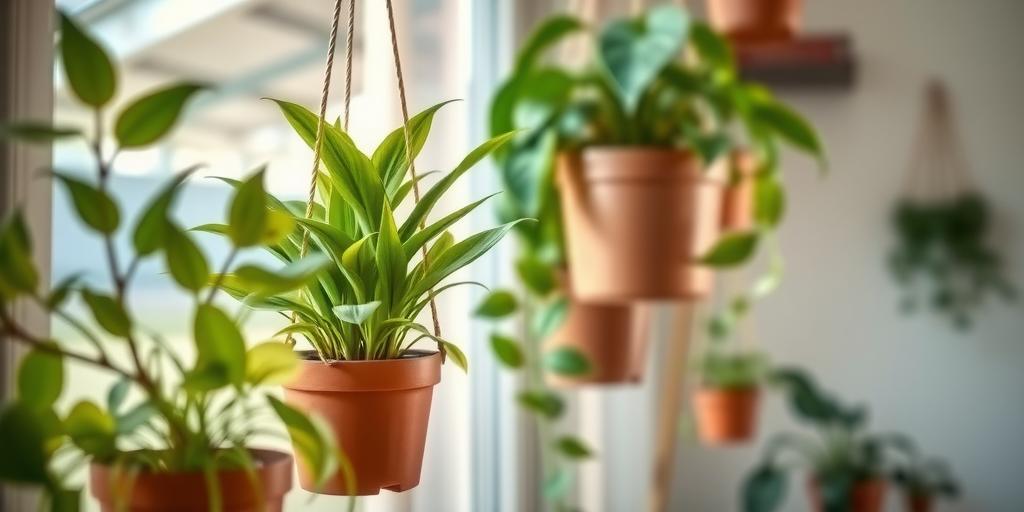
Easy Low Maintenance Hanging Plants for Beginners to Grow Successfully
Discover the best easy low-maintenance hanging plants for beginners! Learn how to grow them successfully with minimal effort and brighten up your space effortlessly.
Introduction
Looking to add a touch of greenery to your home without the hassle? Hanging plants are a fantastic way to bring life to any space—especially if you’re a beginner! Did you know that indoor plants can boost your mood and purify the air? The best part? You don’t need a green thumb to keep them thriving. In this guide, we’ll explore the easiest low-maintenance hanging plants that even beginners can grow successfully. Let’s dive in!
Why Choose Low-Maintenance Hanging Plants?
If you love greenery but don’t have the time (or memory) for high-maintenance plants, low-maintenance hanging plants are the perfect solution. They’re ideal for busy lifestyles—no need to stress about daily watering or complicated care routines.
For small spaces, hanging plants add vertical greenery without taking up precious floor or shelf space. Many varieties thrive in indirect light, making them perfect for apartments or rooms with limited sunlight. Plus, most require minimal pruning, so you can enjoy lush foliage without constant upkeep.
Top 10 Easy Low-Maintenance Hanging Plants for Beginners
1. Spider Plant
Spider plants are practically indestructible. They adapt to various light conditions, purify the air, and even produce “pups” (baby plants) that you can propagate. Perfect for forgetful waterers—they bounce back quickly if neglected.
2. Pothos (Devil’s Ivy)
Pothos is a fast-growing vine that thrives in low light and can handle irregular watering. Its trailing vines look stunning in hanging baskets, and it’s one of the easiest plants to propagate in water.
3. String of Pearls
This unique succulent features bead-like leaves that cascade beautifully. It’s drought-tolerant, so it’s great if you tend to forget watering. Just give it bright, indirect light, and it’ll thrive.
4. Philodendron Heartleaf
With its heart-shaped leaves and fast growth, this plant is forgiving and low-maintenance. It tolerates low light and occasional missed waterings, making it perfect for beginners.
5. Burro’s Tail (Sedum Morganianum)
A succulent that loves neglect, Burro’s Tail stores water in its plump leaves. It prefers bright light and infrequent watering—overwatering is its only real enemy.
6. English Ivy
A classic trailing plant, English Ivy does well in shaded spots and adds a touch of elegance. It’s great for hanging baskets but can be invasive outdoors, so keep it contained indoors.
7. Peperomia
Compact and charming, Peperomia varieties like the “Watermelon” or “String of Turtles” have low water needs and thrive in moderate light. Their small size makes them ideal for tight spaces.
8. Air Plants (Tillandsia)
No soil? No problem! Air plants absorb moisture through their leaves and only need occasional misting or soaking. They’re perfect for creative displays in hanging terrariums or driftwood.
9. String of Hearts
Delicate and romantic, this trailing succulent has heart-shaped leaves and is drought-resistant. It loves bright, indirect light and can handle occasional neglect.
10. ZZ Plant (Zamioculcas Zamiifolia)
Nearly indestructible, the ZZ plant thrives in low light and can go weeks without water. Its glossy leaves add a modern touch to any space.
Essential Care Tips for Healthy Hanging Plants
Light Requirements
Most hanging plants prefer bright, indirect light. Direct sunlight can scorch leaves, while too little light may slow growth. East or north-facing windows are usually ideal.
Watering Needs
Overwatering is the #1 killer of houseplants. Let the soil dry out between waterings—stick your finger in the soil; if the top inch is dry, it’s time to water. Succulents and air plants need even less frequent watering.
Soil & Potting
Well-draining soil is a must to prevent root rot. Use a mix with perlite or orchid bark for better drainage. Always choose pots with drainage holes to avoid soggy roots.
Fertilizing
Less is more. Feed your plants lightly during the growing season (spring and summer) with a balanced liquid fertilizer. Skip fertilizing in winter when growth slows.
Pruning & Maintenance
Trim dead or yellowing leaves to encourage new growth. For trailing plants like Pothos or Philodendron, occasional pruning keeps them looking full and prevents legginess.
Best Places to Hang Your Plants for Optimal Growth
Near East or North-Facing Windows
These spots provide gentle, indirect light perfect for most hanging plants. Avoid harsh afternoon sun from south or west windows unless your plant loves bright light (like Burro’s Tail).
Bathrooms with High Humidity
Plants like Pothos, Ferns, and Philodendrons thrive in humid environments. If your bathroom gets some natural light, it’s an excellent spot for lush growth.
Shelves or Macramé Hangers
Elevate your plants with stylish hangers or shelves to create a cascading green display. Just ensure they’re not too far from a light source.
Avoid Direct Sunlight
Unless your plant specifically loves full sun (like some succulents), keep them out of direct rays to prevent leaf burn.
Common Mistakes to Avoid with Hanging Plants
Overwatering (Leading to Root Rot)
More plants die from overwatering than underwatering. Always check soil moisture before watering, and ensure pots have drainage holes.
Using Pots Without Drainage Holes
Trapped water leads to root rot. If you love a decorative pot without holes, use it as a cover pot and keep the plant in a plastic nursery pot inside.
Ignoring Pest Checks
Spider mites, mealybugs, and aphids can sneak in. Regularly inspect leaves (especially undersides) and treat pests early with neem oil or insecticidal soap.
Placing in Extreme Temperatures or Drafts
Avoid spots near heaters, air conditioners, or drafty windows. Most houseplants prefer stable temperatures between 60-80°F (15-27°C).
By choosing the right plants and following these simple care tips, you can enjoy lush, thriving greenery with minimal effort. Happy hanging!
Conclusion
Growing hanging plants doesn’t have to be complicated! With the right choices—like spider plants, pothos, or string of pearls—you can enjoy lush greenery with minimal effort. Remember to provide proper light, water sparingly, and give your plants a little love. Ready to transform your space? Pick your favorite low-maintenance hanging plant and get started today!
